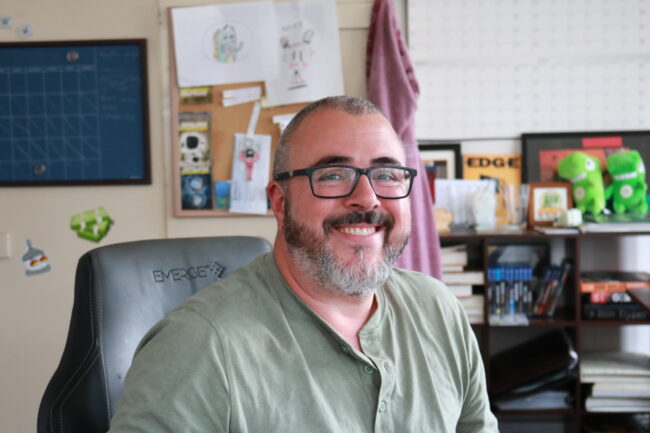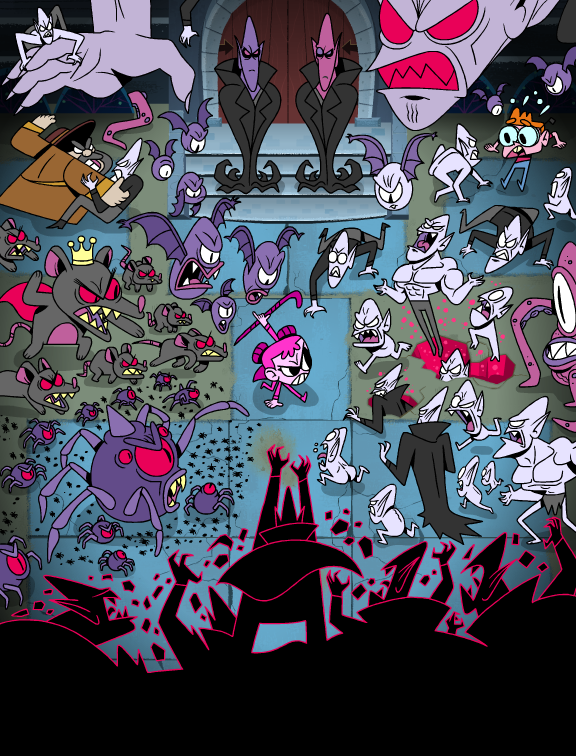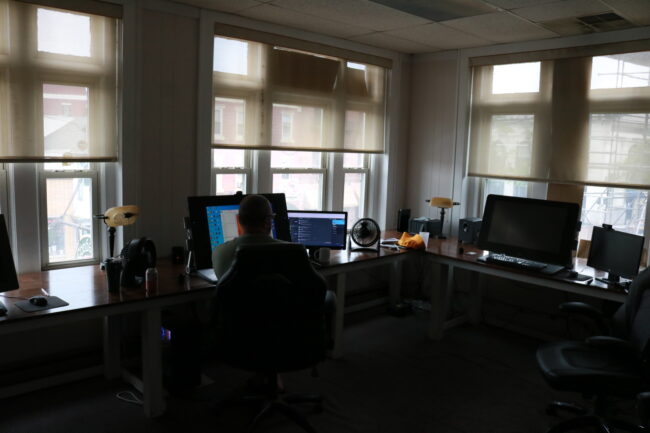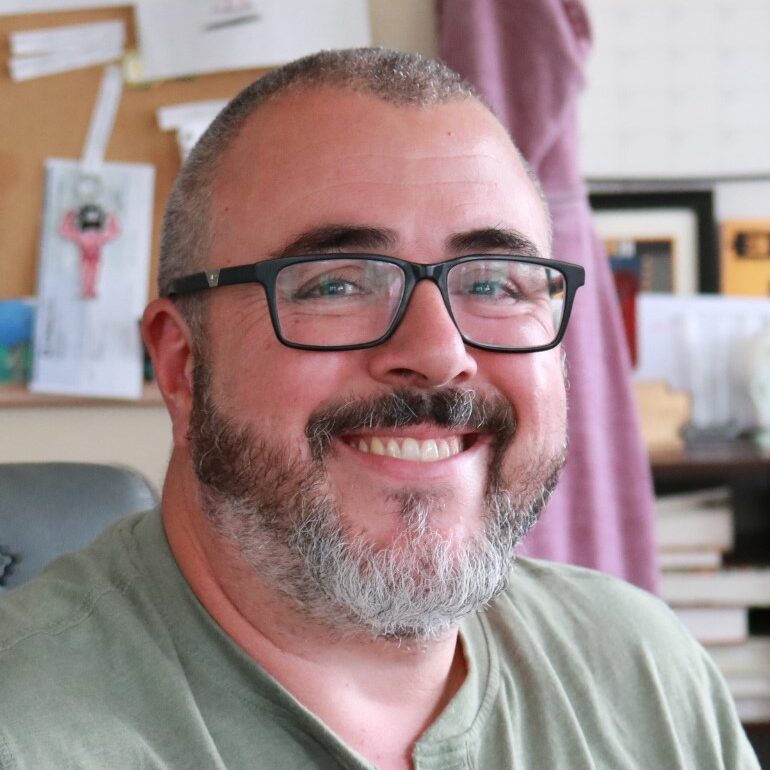A conversation between Exit 73 Studios co owner Chris Burns and Doug Vitarelli with ASIFA-East intern Katelynn Duarte
If you need a coffee while you’re traveling to Montauk to meet up with NY State’s easternmost based animator, there’s a little cafe on Main St. in Riverhead that serves a nice cup. Just get off exit 73 and it’s right there.
And while you’re sitting there enjoying your coffee and wondering about house prices and the commute to the city, take a look across the street to the 2nd floor above Star Confectionary. Inside those window sills that are in desperate need of a paint job is the home of Exit 73 Studios, a boutique animation studio that’s been creating awesome animation for over 20 years.

How did you begin?
Well I started my animation career working part-time on the Venture Brothers at Noodle Soup in 2002.
And then I worked in the city for about seven years before we started the studio, which is now about 14 years old, give or take.
Have you been in this space that long?
Yes. We’ve been in this town called Riverhead on the East End on Long Island and it’s where me and my business partner grew up, went to high school together, went to SVA together.
And we both had fiancés and were talking about raising families and everyone was from out here and the social aspects of the city that were fun in my 20s were less fun in my 30s.
So we all collectively decided, all four of us, that maybe we should try to start something out here. it just seemed like the right thing to do.

Did you have any clients?
No, we (with co owner Bob Fox) had a decent reputation and always seemed to find work. Animation was a little different back then. There was a lot of it going on in the city, and we were constantly employed.
And we both kind of took a little bit of different pants. He was more on the children’s entertainment side of things.
I was working for a studio called Augenblick Studios, they’re just celebrating their 25th anniversary, which is focused more on the adult side. I had Comedy Central and Adult Swim and all that stuff and he’s worked for like the opposite, Nick Jr, Nickelodeon and all those so between the two of us we had a lot of contacts of like on both sides of the industry.
So you only do 2D?
Yeah we don’t do 3D, we’re all traditional. And from there we just kind of took the risk and reached out and told everyone that we’re working on our own thing and at that time were taking freelance on the side just to fund the studio.
Our first break was with our friend, Joe Croson who helped fund one of our first cartoons. He’s over at Netflix now. And from there, we used that project to build more and more. Once you get work and build a reputation the work comes a little easier, and you build your portfolio. So from there we just slowly got more clients, until we could stand on our own two feet without the freelance work.

About how long did that take?
About a year and a half. It doesn’t feel very long now but that was a turbulent time. There were times where it was hard to pay each other, that’s for sure.
But we had a low overhead and it’s just the two of us. So pretty much you’re paying just two freelancers but there’s definitely difficult times where we’re just like, “Oh, you know, there’s nothing in the bank.”
We relied a lot on the contacts, which was nice about the animation industry. It’s somewhat small so you get to know people and you know that there’s no shame in asking for work.
What are disadvantages of operating in the Northeast, but not New York City?
Well, low overhead, for sure. Riverhead is a lot cheaper.
And now that everything’s global and all meetings with people on the west coast are with Zoom and Skype the hardest part is aligning the time zones but the advantage for that is definitely low overhead and easier to manage and pivot.
Disadvantages of course is the city just has a more robust animation scene so if there’s a mixer or something where you’re going to meet other clients or stuff, we don’t have the luxury of going there as quickly.
I’ve looked at your website, and you have some really amazing work and a lot of it.
Oh, thank you. Yeah, 14 years, you’ll get a lot.
I’m sure you’ve got like 100 things that don’t even make it to the website.
Oh yeah, that website we have to update for sure.
Can you explain your jobs?
Well we’re mostly focused on short form animation, anything from like 30 seconds and on. The most we’ve done in a single short was 11 minutes.
But we just recently made a video game. That was all hand drawn and that was about 19 minutes and cutaways.
But mostly short form stuff, on average about two to five minutes. It’s just the two of us so it’s easy to manage rather than a whole season of stuff to animate.
So do you hire freelancers?
We have hired one or two in the past. But only, when things were real crunch time. I’d say 90 to 95 percent it’s all just Bob and myself. He focuses a lot on the backgrounds, post-production and does music too. He wears a lot of hats.
I’m more a character animation so we kind of pair well together, though, we swap too. You know, when things get too busy I’ll do some storyboards as well as some backgrounds.

Do you think he, either of you could have done it by yourselves?
No, not initially and still not now honestly. And when you’re going in (to meet clients) we never really mentioned that we were just two people. I think a lot of them might shy away from that sometimes.
We come from working with big teams because we were doing a lot of series work. You know, 30-40 people on a team. So going from 40 to two people and we’re wondering: how are we going to do this? And then we sort of just figured out a way and now we have a system.
Do you find that it’s more liberating when you have more skin in the game? You feel like you’re more creative? I know that when I worked in studios I would do one part of a commercial and everyone else did their part and it all came together, but when it’s just the two of you, is it more exciting?
Oh yeah, I love running a business. There’s a lot more at stake, for sure. I think it pushes you to be a little more independent, a little better at your craft. And when it’s just the two of us, you find creative ways to come up with a solution for sure. When we do something that has a tight turnaround for example, we’re still doing everything from the storyboardings to post and it’s like: “Let’s make this not easy on ourselves but manageable.”
So when there’s no surprises in storyboards, like 100 people in a scene. We do it in a creative fashion and with two people and still feel like it was done by professionals.

Talk to me about #BLUD.
The story goes, we were working with Disney on a pilot called Coin, which was one of our original IPs and we’re waiting for scripts. Bob and I have always been pretty good about when there’s ever some down time to get a new idea rolling, which just keeps the creative pieces flowing.
It’s an homage to Buffy the Vampire Slayer about a teenage girl field hockey player who has to live going through high school and she’s put in a position where she has to kill vampires and we did a 45 second teaser, almost like a trailer.And since we’re working with Disney, we’re like, let’s show them this and we did.
They found it interesting but they wanted us to focus more on the pilot and so we shelled it. Years later another roommate, Cody Greenhalge, who’s a partner on the other side of the gaming studio we run, wanted to make a video game with us. We’ve been friends forever and he’s a programmer and said, “Yeah, that’s something interesting.”
And we just kind of look through a bunch of pitch packets and he sees #BLUD and says “This is interesting, it could be even better as a video game than a series.”
And then we’re sort of like, yeah, let’s do it and then we’re off to the races. We changed the style from the trailer and it took about seven years from a 45 second trailer to a finished the game.
We got published about two two three years in, after working the indy game scene, making demos and showing it off. Finally got the attention of a company called Humble Bundle. And from there we’re granted access to funds to finish the game.
It was a really long journey.
Are you working on any current uh your own IPS at the moment?
Yeah, we’re kind of picking up on a new kind of video game.

So, what hardware and software do you use?
We all use Cintiq and an ancient program called Macromedia Flash MX.
Oh, and we didn’t upgrade to Windows 11 yet, we’re on Windows 10 and it works as long as you’ve run it as administrator. I guess I’m just a creature of habit and that’s what I worked on when I started in the industry in 2002.
I like the line quality of it and every kind of iteration from Adobe I felt like the brushes were getting a little worse and a little bogged down. So in terms of efficiency, we always use Flash MX because it’s bare bones.
It’s like we’re just drawing frame by frame animation, let’s not complicate this.
What are the goals of Exit 73?
Oh, I definitely want to pivot to the video game scene.
I like that there’s a lot more freedom in terms of storytelling and video games are so broad that you can kind of focus on the style you like. #BLUD was an homage to Gandhi and Powerpuff Girls and McCracken and all kinds of late 90s Cartoon Network series.
And there is no executive to say no you have to draw it like this or stay on model and all that stuff. So I found video games a little more liberating in that regard and the indie game scene is just excited to see animation. It was just a lot more creative freedom, plus when you add interaction to like animation it just feels like kind of the next evolution of like what we wanted to do in terms of storytelling.

Do you have any advice for Caitlin and others who are coming into the industry?
Yeah. Oh boy, right now, it’s tough. I don’t think people should be as worried about Ai as a lot of people think. It’s not gonna crash [the industry] but I just don’t think people are going to use it pragmatically and I do happen to find it unethical personally.
I recommend to anyone coming into animation to try to make a film on your own. And try to find what you like about making a film, do every stage or at least have a hand in every stage because you’ll kind of find your voice in that.
Like, whether you really enjoy the storyboarding part or maybe the background design, the character, all that stuff, but I also like to recommend that so you have a perspective of whatever you want to do.
But I always recommend making a film because there’s multiple uses for it. You can throw it on YouTube when it’s finished and spread it around and be like, hey, I made this and you learned something about yourself making a film the last time I made, I learned something still. And that wasn’t that long ago.
And keeping up on your portfolio and with some trends. I don’t focus too much on the technology aspect of it. I believe in the craftsmanship, so I just focus on skills. And then, as I mentioned earlier, once you get your foot in the door, things come exponentially easier. But you know, and that’s coupled with hardships, like the industry’s having right now. Also it’s always good to be able to pivot. Don’t be so set in your ways that you’re only a storyboard artist.
Thanks Chris.
Of course, thank you.

